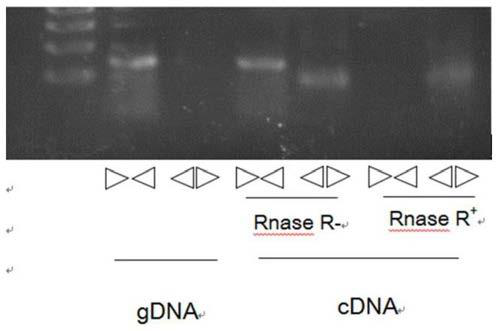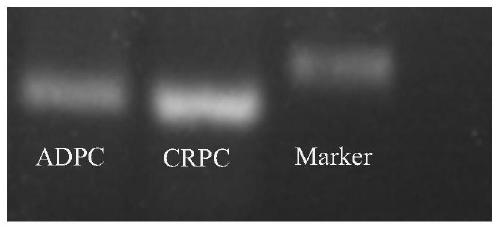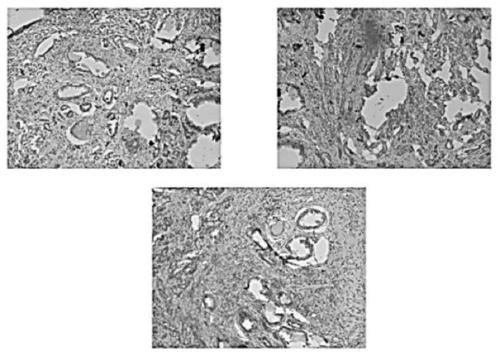CircRNA relevant to prostatic cancers and application of circRNA
A prostate cancer and product technology, applied in circRNA and its application fields, can solve the problems of lack of accurate treatment of etiology, unknown pathogenesis of CRPC, etc., and achieve the effect of precise treatment
- Summary
- Abstract
- Description
- Claims
- Application Information
AI Technical Summary
Problems solved by technology
Method used
Image
Examples
Embodiment 1
[0041] Example 1 Design and verification of primers for circRNA
[0042] 1. Design of circRNA primers
[0043] Download the fasta format sequence of has_circ_0092339 on circBase. The first and last two bases of the obtained original sequence are indicated with a special color. Cut any point in the original sequence, cut all the points from this point to the end of the sequence, and then move them to the front of the original sequence together to form a new sequence. The first and last clips of the original sequence become two consecutive bases in the new sequence, forming a back-splicing site. Design primers for novel sequences. Among them, the back primer requires spanning the reverse cleavage site. The primers designed here are back-to-back primers, and the back-to-back primer sequences are shown in SEQ ID NO.1-2; find the transcript of the circRNA in circBase, and design primers for the transcript. This primer is called a face-to-face primer, and the face-to-face primer...
Embodiment 2
[0056] Example 2 Verification of circRNA in patient tissue
[0057] 1. Collection of samples
[0058] Tissue samples of prostate cancer patients admitted to our hospital were collected, including 5 cases in each group of ADPC and CRPC, excluding those with a history of mental illness, abnormal cognitive and understanding functions, suffering from other malignant tumors, and those who could not undergo radical surgery due to special reasons patients with sex resection.
[0059] 2. Grinding of patient tissue homogenate
[0060] Take out the patient's tissue from the -80°C refrigerator, cut the size of mung bean, put it into the grinding rod immediately, add 1ml of normal saline mixed with ice water, and grind it repeatedly with the grinding rod until it becomes a homogenate. Draw 1ml homogenate, add 1ml trizol, shake vigorously, and mix well. Then incubate on ice for 5min to make 2ml premix
[0061] 3. Extraction of total RNA from patient tissue
[0062] Pipette 1ml of the ...
Embodiment 3
[0067] Example 3 Base Scope Verification of Patient Tissue
[0068] 1. Patient tissue paraffin section
[0069] Soak the excised tissue in 10% neutral formalin fixative solution at room temperature for 16-32h. Samples were then washed with 1×PBS. Dehydration was performed with a gradient of standard ethanol and finally xylene. Paraffin embedding was performed conventionally. Adjust the slice thickness to 4 μm for tissue sectioning. Place the excised paraffin sections containing tissues in a 40-45°C water bath. Pick up the slices with a glass slide, being careful not to overlap. Dry at room temperature overnight.
[0070] 2. HE staining
[0071]Before performing Base Scope, HE staining should be performed to confirm the position. Firstly, it is dried in an electric oven at 75°C for 1 hour, and then dewaxed in cylinders. The corresponding organic solvents and time are shown in Table 1, and the order in the table is the order of passing through the tank.
[0072] Table ...
PUM
 Login to View More
Login to View More Abstract
Description
Claims
Application Information
 Login to View More
Login to View More - R&D
- Intellectual Property
- Life Sciences
- Materials
- Tech Scout
- Unparalleled Data Quality
- Higher Quality Content
- 60% Fewer Hallucinations
Browse by: Latest US Patents, China's latest patents, Technical Efficacy Thesaurus, Application Domain, Technology Topic, Popular Technical Reports.
© 2025 PatSnap. All rights reserved.Legal|Privacy policy|Modern Slavery Act Transparency Statement|Sitemap|About US| Contact US: help@patsnap.com



